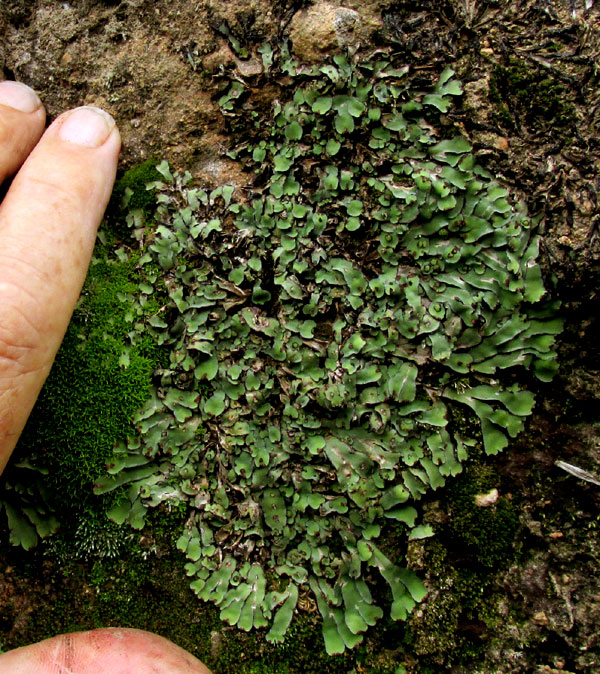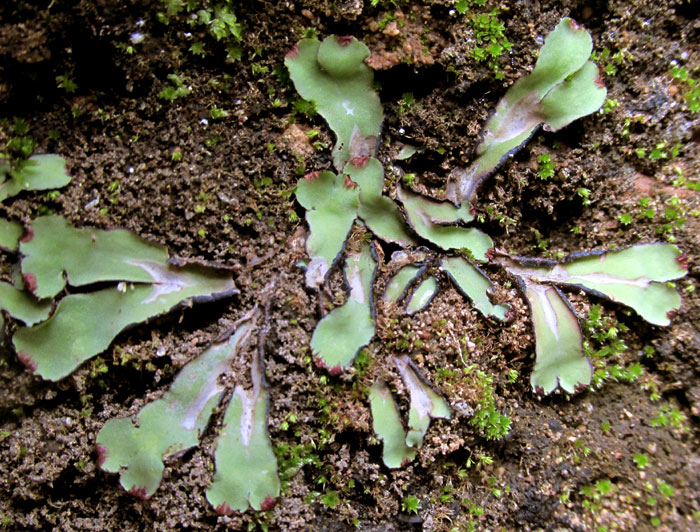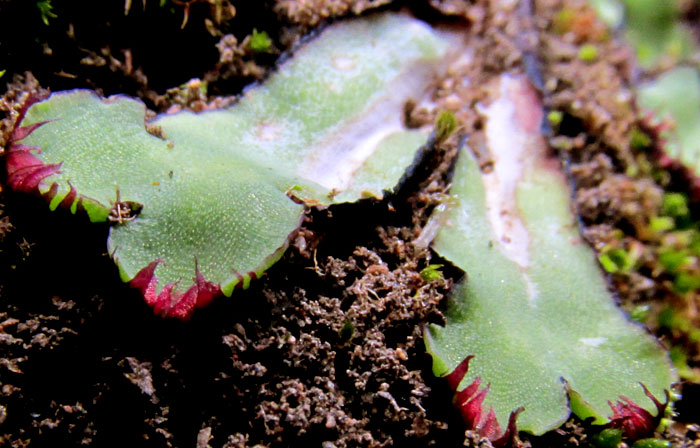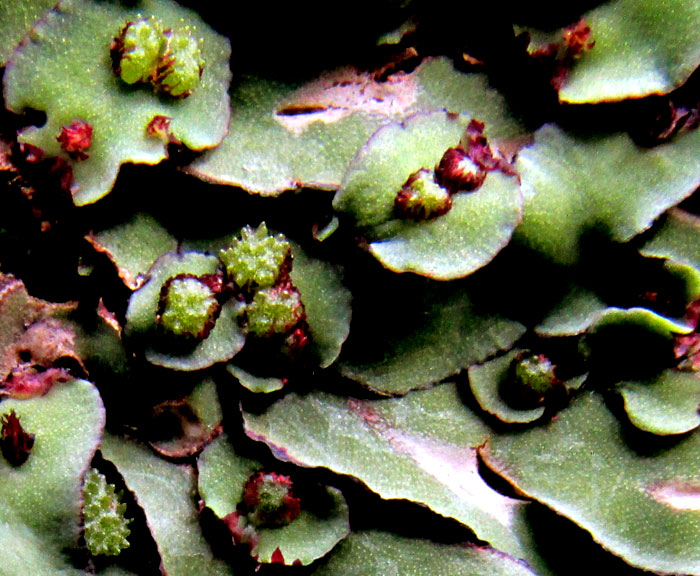Excerpts from Jim Conrad's
Naturalist Newsletter
entry dated September 1, 2022, issued from near Tequisquiapan, elevation about 1,900m (6200 ft), N20.565°, W99.890°, Querétaro state, MÉXICO
MARCHANTIA cf. INFLEXA

On the east-facing vertical dirt wall of a ravine mostly shaded by overhanging trees, the above colony of liverworts seemed to be prospering. No field guide to liverworts exists for this area, so one just has to know that when you see ribbonlike plants like the above, forking as they grow across a substrate, you're seeing a liverwort. Liverworts can be leafy or thallose, and this one is thallose. Thalli are vegetative bodies not differentiated into distinct parts such as stems, leaves and roots, and don't grow from a single point at their body tips. Algae, fungi, mosses and liverworts can have thallose forms. Beside the colony seen above, a new colony was just establishing itself:

Above, you can see how the colony begins in one place, then thalli begin growing outward from the center. Note how the thalli have forked as they progressed. The forked-off parts will fork again, and then those forks will fork, on and on. Here's a close-up of some thalli's leading parts:

Notice that in the center of each thallus head there's a cleft where the future forking will take place. Also, the purple, upward-pointing scales at the thallis' front are noteworthy. These scales cover the thallis' bottoms, so the ones we see are just those at the margins. On the thalli's undersides also there are rootlike rhizoids, which are one-celled, downward-growing projections functioning as roots. They anchor the plant and absorb water and minerals.
Above, note how the thallus bodies are covered with tiny, pale dots. Each dot is a pore, or opening, where gases from the air and the liverwort's body can come and go. Beneath the pores lie air chambers where gases mix. Basically, the plant "breathes" through these pores. The pores and the hard-to-see, diamond-shaped markings they're in the center of, remind some people of the surface of a liver, therefore "liverwort."

Inside the larger colony, many thalli bore cuplike structures such as those shown above. Those are gemma cups, inside which grainy gemmae are forming. Gemmae are basically vegetative buds, and they're asexual reproduction bodies -- no sex was involved for them to form. Each gemma can form a new liverwort, a clone of the parent. Usually asexual reproduction is the most common way thallose liverworts reproduce. They do have a sexual process, though, for which special tiny, umbrella-shaped structures are formed, but our liverwort had none of those.
In this part of the world, when you have a thallose liverwort looking like the above and growing in the same manner, probably you have a member of the genus Marchantia. There's another commonly occurring, ribbon-like thallose genus, Riccia, but its surface lacks the white pores in the center of diamond-shaped markings, plus Riccia doesn't produce gemmae.
For identification purposes, once you know you have a Marchantia, if you don't have sexual parts to examine with magnification, it may be hard to impossible to decide which species you have. Marchantia taxonomy at the species level is poorly understood. Until now a number of different forms of Marchantia have been clumped together in the species Marchantia polymorpha, and now it's unclear whether some or most or any of those forms represented different, maybe unknown species. Also, if you do an image search on the keyword "Marchantia," you'll see many pictures of Marchantia labeled as various species, but seeing consistent differences between the species may be hard or impossible. The impression is that many of the species are wrongly identified.
Only a small percentage of Marchantia pictures show individuals producing such dark purple scales as our plant's. I find that most of those who do have them are labeled either as Marchantia polymorpha or Marchantia inflexa.
Still, after reviewing hundreds of labeled photos of various Marchantia species, I have a general, subjective, utterly unscientific notion that probably the liverwort in the above pictures is MARCHANTIA INFLEXA.
My grounds for the choice are that pictures of Marchantia polymorpha suggest a species which, on the average, exhibits somewhat broader thalli than Marchantia inflexa, plus a smaller percentage of images labeled Marchantia polymorpha display scales of such dark, deep purple, than do those labeled Marchantia inflexa. Moreover, Marchantia inflexa is a tropical American species found from southern Florida and the Caribbean south through Mexico into northern Venezuela, and is to be expected here.
The two species are very closely related. S. Kumar and others in their 2017 study entitled "TimeTree: A Resource for Timelines, Timetrees, and Divergence Times" assert that Marchantia inflexa diverged from its "sister species" Marchantia polymorpha some 68-126 million years ago. This means that they both arose from an immediate common ancestor, and share more genes with one another than with any other species. This implies that results of the many studies of Marchantia polymorpha may well apply to our inflexa species as well.
Fairly little is known about Marchantia infelexa. However, liverworts in general have a long history of being used medicinally, their cures being touted in ancient Greek medical texts. Arvind Jantwal and others, in their 2019 publication "Pharmacological potential of genus Marchantia: A Review" state that Marchantia polymorpha "... is used as antipyretic {reduces fever}, antihepatic {liver problems}, antidotal {acts as an antidote}, diuretic {increases urine flow} activity; used to cure cuts, fractures, poisonous snake bites, burns, scalds, and open wounds."
Numerous clinical studies agree that Marchantia polymorpha extracts display antioxidant and antifungal effects. Fangfang Zhou and others in their 2021 article "Marchantia polymorpha L. ethanol extract induces apoptosis in hepatocellular carcinoma cells via intrinsic- and endoplasmic reticulum stress-associated pathways" found that an ethanol extract of Marchantia polymorpha significantly suppressed the migration and growth of various kinds of cancerous cells.
By the way, by liverwort standards, the divergence of our Marchantia inflexa from Marchantia polymorpha 68-126 million years ago wasn't particularly long ago; Liverworts were well established along with mosses, hornworts, lycophytes, ferns and seed plants at least by 360 million years ago. According to the 1997 work by P. Kenrick and P.R. Crane entitled "The origin and early evolution of plants on land," liverworts are the original land-based ancestors -- the "basalmost lineage," in cladistic talk -- of all land plants.